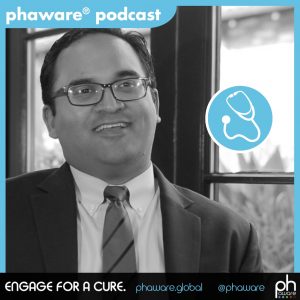Phaware Podcast: Tim Fernandes, MD

This podcast series, created and produced by phaware, is being offered as a regular guest feature on Pulmonary Hypertension News to bring the voices and life experiences of PH patients, family members, caregivers, healthcare specialists, and others to our readers. You may listen to the podcast directly, or read it via the transcript that runs below.
I’m Aware That I’m Rare: Tim Fernandes, MD
The phaware® interview (Episode 90)
Timothy Fernandes, MD, MPH, is a board-certified pulmonologist who focuses on pulmonary vascular disease. He has a special interest in caring for patients who have venous thromboembolism, pulmonary arterial hypertension, and chronic thromboembolic pulmonary hypertension. Fernandes is active in clinical research, investigating the progression of acute pulmonary embolism to chronic thromboembolic disease (CTEPH), and patient outcomes following pulmonary endarterectomy (PTE) surgery.
I’m Tim Fernandes. I’m an assistant clinical professor of medicine at the University of California San Diego. I am a pulmonologist, and I specialize in pulmonary  vascular disease. I see all facets of pulmonary vascular disease, from acute pulmonary embolism to chronic thromboembolic pulmonary hypertension, and I also treat pulmonary arterial hypertension.
vascular disease. I see all facets of pulmonary vascular disease, from acute pulmonary embolism to chronic thromboembolic pulmonary hypertension, and I also treat pulmonary arterial hypertension.
There is a lot of interest in chronic thromboembolic pulmonary hypertension, and it’s an exciting time, because there’s a number of new centers coming online and patients are being afforded centers locally that can treat them. UCSD really pioneered the surgery in the early ’70s and perfected it in the ’80s and ’90s. Now, we’re sort of teaching the world how to best manage these patients and how to take care of people with this disease.
I came to UCSD knowing that I wanted to do pulmonary hypertension. As a resident [physician] in Cleveland, I was exposed to patients with pulmonary arterial hypertension. It was a nice blend of physiology and patient care, where you could really help people. Specifically, chronic thromboembolic pulmonary hypertension is potentially curable. And so you can have patients that are very sick who come to San Diego for surgery and walk out cured of their pulmonary hypertension and go on to live normal lives and run marathons and do all the things that people should be doing. So, it’s a very gratifying job.
Two groups
With chronic thromboembolic pulmonary hypertension, there’s really two groups of patients. There are patients who clearly have an inciting pulmonary embolism, so a blood clot that starts in their lungs or ends up in their lungs, usually starting from the legs and traveling and ending up in the lungs. The vast majority of people with a pulmonary embolism, once they’re treated with anticoagulation, that pulmonary embolism will go away. In a small minority of patients, they may develop a scar rather than have that clot dissolve and that scar can lead to pulmonary hypertension and cause people to be very symptomatic.
The other group of patients that we see is people who really don’t have a known, provoking pulmonary embolism, but just have seen progressive shortness of breath over a number of years. As part of the evaluation of shortness of breath, I think that clinicians really need to think about, “Is this something more exotic than just asthma or COPD or heart failure? Is this a chronic blood clot that could be surgically cured?”
Not everyone is a candidate for surgery. I think that what we’ve learned is at very experienced centers like UC San Diego, we are able to get further out than other centers. We’re able to get more distal clot out. We’re able to take patients who are having other co-morbidities, who are maybe very obese, or who have lung disease, or heart disease or other problems. So, I would encourage everyone, if they are evaluated and turned down, that they should really seek a second opinion by a center that’s really doing a lot of these surgeries, because there are patients who are turned down by one center and offered surgery at a more experienced center.
Having said that, even patients [who] come to San Diego, there are some patients who we just can’t offer surgery to. There are two developments in the last few years that have really helped these patients. One is, now we have an approved agent for inoperable CTEPH [chronic thromboembolic pulmonary hypertension). It’s a medicine that’s pretty well-tolerated and really showed, in clinical trials, a marked improvement in six-minute walk distance, marked improvement and improvement in functional status, and those are really what we want to do.
New program
Now, in the last year, we, some of our partners, have started a balloon pulmonary angioplasty program. Maybe patients have too many co-morbidities and are too high risk for surgery, they could be considered for a balloon pulmonary angioplasty, where we use a small balloon and a catheter to blow up and smash this chronic clot into the vessel wall and restore flow to those areas that were occluded by chronic blood clots.
Still, the screening test of choice for chronic thromboembolic pulmonary hypertension is a study called a V/Q scan. The V/Q scan, we like because it is either normal or abnormal. If it’s abnormal, there are more studies that can be done to determine whether it’s abnormal because of chronic blood clots or something else. Things like a CT scan of the chest with contrast can look for chronic blood clots, but really still, the V/Q scan is the screening test of choice.
There are studies like an echocardiogram where we can measure or estimate pressures and look at how the right heart that’s pumping the blood through these diseases lungs that are occluded by clots, how that is functioning. Really, the final step in the algorithm is a right heart catheterization and a pulmonary angiogram, where we inject dye into the right and the left side and really determine surgical candidacy based on the hemodynamic measurements from the right heart catheterization and the location of the chronic blood clots that we see by the pulmonary angiogram.
One of my focuses is in the follow-up after an acute pulmonary embolism, and I think that it’s important for people to know that after a blood clot, with proper anticoagulation, you should get back to normal. If you’re not back to your baseline, it’s on you to talk to your doctor about further testing to see if maybe this has caused a scar and maybe you have started to develop pulmonary hypertension due to chronic blood clots. It’s important to find this early because outcomes from surgery are better with earlier diagnosis and earlier treatment. I encourage people, if they had a blood clot, to seek medical attention if they’re not back to normal by six months.
The other group of patients that we really need to identify is in patients who have a diagnosis of pulmonary hypertension. I feel like the use of V/Q scanning is tremendously underutilized. I’d encourage everyone on the website that has a diagnosis of pulmonary hypertension to talk to their doctor, make sure that they’ve had a V/Q scan, and make sure that chronic thromboembolic pulmonary hypertension has been ruled out.
CTEPH is a potentially curable form of pulmonary arterial hypertension. If you’ve had a V/Q scan, there are multiple options for you if perfusion defects are present. It’s important for patients to get connected to physicians who specialize in the treatment of pulmonary arterial hypertension. Those physicians also can manage chronic thromboembolic pulmonary hypertension and can also get you hooked up to the right surgical centers for assessment and determination of your operability.
I think that we really need to really expedite the timeline and get patients to centers sooner so that they’re not out their languishing. Some of the work that I do is looking for potential blood tests and biomarkers of who has developed CTEPH. Hopefully, in the future, we can use some of these blood tests to find patients sooner and identify them and get them to the right place.
EVERYBODY HAS A STORY. WHAT’S YOURS?
Phaware global association wants to share your pulmonary hypertension story with their engaged global audience. Whether you are a patient, caregiver, or medical professional, they are enlisting PH community members from around the world. Visit www.phawarepodcast.libsyn.com/contact to share your story and to be considered for a future episode. Never miss an episode with the phaware® podcast app. Learn more about pulmonary hypertension at www.phaware.global. #phaware
***
Note: Pulmonary Hypertension News is strictly a news and information website about the disease. It does not provide medical advice, diagnosis, or treatment. This content is not intended to be a substitute for professional medical advice, diagnosis, or treatment. Always seek the advice of your physician or other qualified health provider with any questions you may have regarding a medical condition. Never disregard professional medical advice or delay in seeking it because of something you have read on this website. The opinions expressed in this column are not those of Pulmonary Hypertension News or its parent company, Bionews Services, and are intended to spark discussion about issues pertaining to pulmonary hypertension.










Leave a comment
Fill in the required fields to post. Your email address will not be published.